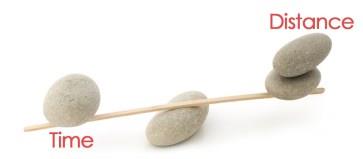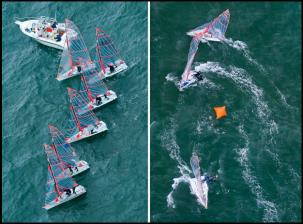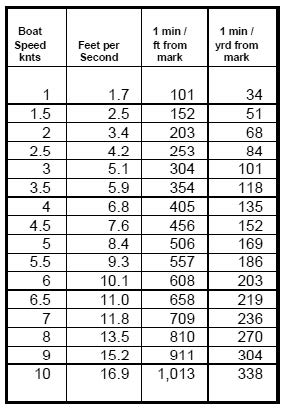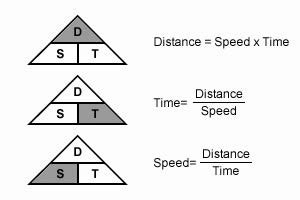Use of a Time and Distance Chart for Starting and Mark Roundings

Recently when thinking about how racers utilize time and distance, I customized a chart to use as a reference for 1 minute of sailing from either a starting line or a mark. The purpose was to help with both starting proficiency and with estimating the length of a starting line.
It also helps coordinate boat handling for either spinnaker sets or takedowns at windward and leeward marks. When taking a closer look at the chart I included feet from the mark as well as yards to help with the estimation of distance. Granted it does not take into account bad air, current or waves versus flat water as well as wind shifts, which change the distance, but what it does do is help a team evaluate how many boat lengths they are going to travel at a certain speed.

Here is an example of usage of the chart from both a starting and boat handling standpoint:
A J 24 with 5 knots of boat speed will travel 8.4 feet per second, so the team will travel a boat length in approximately 2.9 to 3 seconds in clear air and flat water. If it is estimated they are 10 boat lengths from the starting line, then they have a minimum of 30 seconds at full speed (bad air / current/ waves notwithstanding). This knowledge will help prevent a team from sailing too far away from the line and to stay closer to help gauge their final approach.

If the you run the line while timing from the race committee (RC) end to the pin at 5 knots of boat speed and finds that it took 30 seconds, then the line is approximately 10 boat lengths or 240 feet long.
Now it can be determined by compass which end is favored and to what extent as well as the magnitude of the advantage.
Additionally you can count the number of boats in your fleet and then make an informed guess on how much space will be available on the line at the start. You can determine if it is going to be crowded or if there will be good space. If the line is quite short relative to fleet size, then you may find that a port tack approach in lighter air may be harder to execute because of limited space to tack and get up to speed. If the line suggests there will be space then all approaches are equally in play.
If you find that you are 6 boat lengths from the windward mark you are going to have about 18 seconds to set the spinnaker pole and start pre feeding the spinnaker guy ( if appropriate for the conditions). If you are 10 lengths from the leeward mark you are going to have about 30 seconds to raise the genoa, store the spinnaker pole and douse the spinnaker before the rounding. The trick is to consult the chart with your boat’s length and pick out some general boat speeds that you do around the race course. Then you can crunch the numbers to find how many boat lengths per boat speed. The results can help the team make more informed decisions on time and distance both on the starting line and at mark roundings.

Good sailing, have fun and best of luck in your next race!

